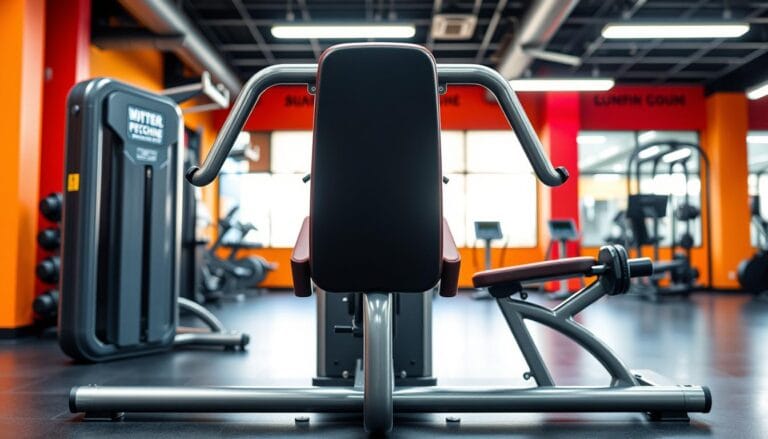Top Cable Back Exercises for Beginners
Table of Contents
Cable back exercises are a great way for beginners to build strength and muscle. They are different from free weights because cable machines give steady tension. This helps improve your back muscles in many ways.
When you try back exercises with cables, you’ll see how they target muscles well and are safer. These exercises work many muscles at once. This makes them perfect for beginners who want to change their body.
Cable back exercises are smart for getting a stronger back. They help improve posture, build muscle, and boost strength. These controlled movements are effective for reaching your fitness goals.
Key Takeaways
- Cable machines offer continuous muscle tension during back workouts
- Exercises can be adapted for different fitness levels and goals
- Reduced joint stress compared to traditional weightlifting
- Enhanced muscle engagement through multiple movement angles
- Excellent option for beginners seeking structured back training
Understanding Cable Machines and Their Benefits for Back Training
Cable machines change back training by offering unique muscle-building chances. They make workouts better with their flexible resistance. These machines help build back muscles in a precise and controlled way.
Cable pulls for back exercises are special because they keep muscle tension steady. This is different from regular weight training. The design gives smooth, ongoing resistance that works muscles from various angles.
Advantages of Cable Resistance for Muscle Growth
- Provides constant muscle tension during entire range of motion
- Allows multiple angle targeting for comprehensive muscle development
- Reduces joint stress compared to traditional free weights
- Enables precise muscle isolation and controlled movements
Training with cable machines can really help your muscles grow. Constant tension stimulates muscle fibers more effectively than the on-again, off-again resistance from dumbbells or barbells.
Safety Features for Beginners
Cable machines are designed with safety in mind. They have adjustable weight stacks and controlled paths to help beginners avoid injuries. This is important because free weights can be risky for newbies.
| Safety Feature | Benefit for Beginners |
|---|---|
| Guided Movement Paths | Prevents incorrect exercise technique |
| Adjustable Weight Increments | Allows gradual strength progression |
| Stable Machine Structure | Reduces risk of accidental weight drops |
Proper Machine Setup and Adjustment
Setting up your cable machine right is key to a good workout. Adjust the cable height, pick the right attachments, and position yourself to target specific back muscles well.
“Precision in setup determines the quality of your cable back workouts” – Professional Fitness Trainer
Learning these basics can change how you train your back. Cable machines offer a new way to grow your muscles.
Back Exercises with Cables: Essential Movements for Beginners
Cable back exercises are a great way to build strength and muscle. As a beginner, you’ll find many powerful movements for your back muscles. These exercises offer constant tension and smooth resistance, perfect for growing muscles.
Let’s look at the top cable back exercises for beginners:
- Lat Pulldowns: A key exercise for your latissimus dorsi muscles
- Seated Cable Rows: Great for strengthening your mid-back
- Standing Cable Rows: Works on multiple muscles at once
- Face Pulls: Focuses on your rear deltoids and upper back
| Exercise | Primary Muscle Group | Difficulty Level |
|---|---|---|
| Lat Pulldowns | Latissimus Dorsi | Beginner |
| Seated Cable Rows | Rhomboids, Trapezius | Beginner |
| Standing Cable Rows | Back, Core | Intermediate |
| Face Pulls | Rear Deltoids | Beginner |
When doing cable pull back exercises, keep proper form and control. Start with lighter weights to get your technique right. Then, you can increase the weight. Each exercise has its own benefits for a strong back.
“Consistency and proper technique are key to mastering cable back exercises.” – Professional Fitness Trainer
Always warm up before working out and listen to your body. As you get better at these exercises, you’ll get stronger, improve your posture, and look more balanced.
Proper Form and Technique for Cable Back Exercises
Mastering cable back exercises needs focus and detail. Your technique greatly affects muscle growth and injury risk. Cable pulls for back workouts are not just about moving weight. They require strategic muscle use and controlled movements.
Your body position and muscle activation are key when doing cable back exercises. Good form helps you target the right muscles and avoid joint strain.
Common Form Mistakes to Avoid
- Arching your back during cable pulls
- Using momentum instead of muscle control
- Gripping the cable handle too tightly
- Neglecting core engagement during movements
Breathing Patterns During Exercises
Breathing is vital in cable back exercises. Proper respiratory technique can enhance muscle performance and reduce fatigue. Here’s how to breathe right:
- Exhale during the concentric (lifting) phase
- Inhale during the eccentric (lowering) phase
- Maintain a steady, controlled breathing rhythm
Range of Motion Guidelines
Knowing the right range of motion is key to avoid injury and engage muscles well. Cable pulls for back workouts should include:
- Full extension without overextending joints
- Controlled movement through entire exercise
- Consistent tension on targeted muscle groups
“Technique trumps weight every time in strength training.” – Professional Fitness Trainer
Getting proper form takes time. Start with lighter weights, focus on your technique, and gradually add more weight as you get better at cable back exercises.
Creating Your Cable Back Workout Routine
Creating a good cable back workout needs careful planning and knowing your fitness goals. Cable back exercises are great for building muscle and getting stronger. Your routine should aim to work different muscles and get better over time.
When making your cable back workout, keep these points in mind:
- Do 2-3 cable back workouts a week.
- Use 4-5 different exercises.
- Do 3-4 sets for each exercise.
- Do 8-12 reps for muscle growth.
It’s important to keep getting stronger in cable back exercises. Start with lighter weights and add more as you get stronger. This helps avoid getting stuck and keeps you safe from injuries.
| Exercise | Muscle Group | Sets | Reps |
|---|---|---|---|
| Cable Lat Pulldown | Latissimus Dorsi | 3-4 | 10-12 |
| Cable Face Pull | Rear Deltoids | 3 | 12-15 |
| Single-Arm Cable Row | Upper Back | 3 | 8-10 |
Recovery is just as key as the workout itself. Give yourself 48-72 hours off between hard cable back workouts. This helps your muscles heal and grow. Pay attention to how your body feels and adjust as needed.
“Consistency and proper technique are the foundations of an effective back training program.” – Professional Strength Coach
Everyone is different, so tailor your cable back workouts to fit your level. Start with what you can do and then push yourself a bit more. Getting advice from a fitness expert can make your routine even better.
Conclusion
Starting your journey with cable back exercises is a big step in strength training. These exercises can help you grow your muscles and get fitter. Cable pull backs are great for working your back muscles well.
It’s important to practice regularly and use the right form. Begin with light weights and focus on how you move. Then, as you get better, you can use heavier weights.
Try different cable back exercises and angles to keep your workouts interesting. This will help you understand how to move better and engage your muscles.
By sticking with it and learning more, you’ll see your strength and posture improve. Keep going, be patient, and enjoy the benefits of cable back workouts.
FAQ
What are the benefits of using cable machines for back exercises?
Cable machines offer many benefits for back exercises. They provide constant tension, target muscles from different angles, and are safer than free weights. This setup helps isolate back muscles and keeps resistance steady throughout the exercise.
How often should beginners do cable back workouts?
Beginners should do cable back exercises 2-3 times a week. Make sure to rest at least one day between workouts. Start with 2-3 sets of 8-12 reps for each exercise. As you get stronger, increase the intensity.
What are the most important cable back exercises for beginners?
Beginners should focus on lat pulldowns, seated cable rows, face pulls, and standing cable rows. These exercises target the latissimus dorsi, rhomboids, and rear deltoids. They provide a full back workout, helping to build strength and muscle definition.
Can cable back exercises help improve posture?
Yes, cable back exercises can improve posture by strengthening the muscles that keep the spine aligned. Face pulls and seated rows, in particular, help the upper back and shoulders. This helps counteract the effects of sitting too long and poor posture.
How do I adjust cable machine settings for maximum effectiveness?
To get the most out of cable machines, adjust the height and weight to fit your body and fitness level. Make sure the seat aligns your body properly. Start with light weights to focus on form, then increase the resistance as you get more comfortable.
Are cable back exercises suitable for people with previous back injuries?
While cable machines are safer than free weights, those with back injuries should talk to a doctor or fitness trainer before starting. Cable exercises can be adjusted for different fitness levels. But, getting medical advice is key for safe training and recovery.
What equipment do I need to perform cable back exercises?
You’ll need a cable machine with adjustable pulleys, found in most gyms. You’ll also need a wide-grip bar, straight bar, rope handle, and single-hand grips. For home workouts, consider a cable machine or resistance bands for similar exercises.
How can I progress in my cable back workouts?
To progress, increase the weight, change rep ranges, or try harder variations of exercises. You can also change grip positions, adjust cable heights, or use drop sets and supersets. This keeps your muscles challenged and helps build strength and muscle definition.





